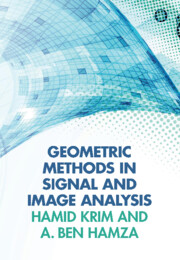1 - Introduction
Published online by Cambridge University Press: 05 July 2015
Summary
This chapter provides a brief summary of what geometric methods for signal and image analysis are all about. Several applications to imaging, computer graphics, and sensor networks are discussed and illustrated. The diversified nature of these applications is powerful testimony to the practical usage of geometric methods.
What is signal and image analysis?
Signal and image analysis refers to the extraction of meaningful information from signals and images using digital signal and image processing techniques. In signal processing, for example, we measure, manipulate, or analyze information about a signal [1]. Such a signal is defined as a function of one or more independent variables that carries information. Examples of signals are daily high temperatures measured over a month, voltages and currents in a circuit, stock prices, our voices, music and speech, images, videos, and emails. Image processing, on the other hand, is the study of any algorithm that takes an image as input and returns an image as output, such as image enhancement, segmentation, compression, inpainting, and feature detection, to name just a few [2]. Application domains of image processing abound and include medical imaging, biology, satellite imagery, and biometrics. Other areas closely related to signal and image processing are computer vision and computer graphics.
Why geometric methods?
In light of the successful use of signal and image processing principles and methodologies in a broad range of areas of exceptional social and economic value, there is a growing demand from within academia and industry to devise robust computational methodologies that uncover the key geometric and topological information from signals and images. Geometry is a branch of mathematics concerned with rigid form, size, and location of objects [3], whereas topology is one of the younger fields of mathematics concerned with properties that are preserved under continuous deformations of objects, such as deformations that involve stretching, shrinking, and twisting but no tearing or gluing [4].
Information
- Type
- Chapter
- Information
- Geometric Methods in Signal and Image Analysis , pp. 1 - 13Publisher: Cambridge University PressPrint publication year: 2015
